The Texas Panhandle seems more accessible since I began moving to Magdalena, New Mexico in 2017. When I was based in San Antonio for twenty-eight years, and Austin for fifteen years before that, Lubbock felt like it was “out there” (in space) or “back there” (in time), but the term that rings true now is “over there,” even right over there. Since January of this year, I’ve been to the Panhandle four times, something that has not happened within a single year in the past five decades.
One of those trips was for the purpose of hearing Ted Waddell speak about his work at the Amarillo Museum of Art. I had known Ted in the mid-eighties, when I lived in Montana, and had not seen him in thirty years.
Waddell’s talk was anecdotal, affable, and full of good humor. Mostly dry. His delivery was exactly as it would be in a bar in Helena or Miles City, full of free association and connection to the land:
“Sagebrush is important — it’s like water — when you think you understand it, you don’t, and it changes.”
A cattle rancher for thirty years, he talks about living places “where you can see for a hundred and fifty miles in every direction,” and points out to a hitch-hiker in the audience that all of his work has a geographical reference.
His sense of place is grounded in Montana, where at seventeen his first teacher was Isabelle Johnson, whose family had homesteaded on the Stillwater River and was part of a group of mid-century Montana modernists.
He manages to find the locus between a rancher, an abstract painter, an art viewer, and let’s say, Charlie Russell, with this hypothetical exchange:
“You say those are just dots, but if I say they are Stillwater Angus, you say yeah, OK.”
In 2020 Waddell published Cheatgrass Dreams, a book of stories and recollections illustrated with oil on paper paintings and graphite drawings. If you’ve ever loved and lost an animal this book will break your heart, or swell it up until it overflows. I liked it so much that I gave it to my neighbor, who has three horses.
In addition to the animal pathos and joy, there are stories of several central Montana characters, one of whom, Tommy Who, earned his nickname from a time he called his mom:
“Hi Mom, it’s Tommy.”
“Tommy who?” was her reply.
Another part of the book pretty much puts a reader right where those Stillwater Angus become dots:
“From what was now a near blizzard without the wind, the dark shape of a few cows took form. They emerged out of the misty, gray, mystical snow, taking shape and moving towards us ever so slowly.”
The overall tone of Ted’s talk is lighthearted, earnest, informative, with sudden turns into the conscience of an ex-rancher. He speaks of his family, his dogs, his art, and shares his life. As a way of introducing a reading from Cheatgrass Dreams he says, “I’ve been very, very lucky. I’ve lived an incredible life and didn’t know why, or, how, or what, but loved it.”
What he reads is devastating, from the final page of the book:
“As I passed through those years, I loved the process of harvest. And especially the cows, as they were palpable beings to me. The endless love for this life — the grass and sky, prairie and wind, mountains and snow, animals and friends — is tempered by the presence and necessity of these choices. Anyone who shrinks away from this life should not be doing it. I couldn’t stand the death-loss anymore. So, I quit. I lost my edge and moved to town, where I became what they call a nickel-plated cowboy. The gut-wrenching, aching finality of what you have done to these wonderful creatures that have lived for you, shared their lives with you, given their all, only to be slaughtered for a last little bit of gain, is untenable. It is the cause of the bad light behind the eyes.”
The next morning, after the talk, I was planning to see a work in progress by London artist Jeff McMillan before heading back to New Mexico.
Waddell and McMillan are of different generations, but are both tempered by some of the same winds — prairie varieties and those currents that have blown through art history.
McMillan tends to make something out of nothing. Likely a habit cultivated growing up in Lubbock, where the horizon is so ever-present it may be taken for granted, giving the present moment sway over any tendency to lean into the future. Not to mention sensitizing an artist to whatever material is in immediate proximity.
He still carries this make-do sensibility, as he did through the educational matrix where he encountered “art supplies” in the form of what he viewed as being almost like product placement, the intentional insertion of advertising in media such as television and movies — “acrylic paint feels very post-war American, like a DuPont product” — and has subsequently found that his studios have tended to be in mixed residential/industrial areas in which tossed out materials are abundant.
One such discovery, a number of years ago, was some thick cardboard garment patterns, mostly sleeves and back panels for leather jackets, that conveniently lent their semi-rectilinear shapes as base material for a series of low-slung house profiles based on residential architecture that was prevalent in mid-century west Texas. These were dipped in paint such that the edge of the pigment formed a phantom horizon cutting through the house-shape, further flattening the “image” while simultaneously offering the suggestion of a shifting frame of reference.
McMillan’s tendency to excavate the geography and tenor of his upbringing appears everywhere in his work: edge/horizon; fold/furrow; linen/cotton. His found materials — a stone wrapped in paper to begin a mark-making process; recycled cardboard boxes cured of corrugated-brown in a dipping process that celebrates the simple planar nature of the container; paintings attached to the exterior walls of his London studio, waiting for weather to complete the task of the artist. All of this speaks to McMillan’s particular collaboration with natural processes, an alchemy of aging and duration, finding as opposed to acquiring, discovery not display.
McMillan’s ongoing body of work, simply titled Hercules Paintings for the location of his London studio, is case in point. Even if the title hints at allegory, it is a story that won’t take place in a heroic landscape, but rather in a world where every day refuse finds reuse and recovery.
The paintings in this group are made of antique linen dipped in oil, via a self-devised pulley system. McMillan points out that the linen long associated with historical European painting was spun from flax, just as oil paint was traditionally made from flax seed. He calls this a “closed loop” with the flax plant, using the same sort of circular logic (contoured plowing) he employs when folds become lines of perspective without representing them.
“I think being in London put me back in the Old World where it wasn’t uncommon to meet painters who would grind up pigment and mix with linseed oil themselves. Very old school, it was like dark-times alchemy still going on. And in that world people were more thrifty, using secondhand materials and the found became not just practical but at times pretty interesting. Things here have history.”
In contrast, New York-born Abstract Expressionism happened on wide bolts of industrial cotton duck, unfurled almost analogously to 19th century expansion, all those Conestoga poke bonnets repurposed and going west, depositing important works on canvas in regional collecting museums, some of which are located squarely in the agricultural expanse of cotton country, suggesting another closed loop.
McMillan’s work stands in contrast to both these trajectories in painting. His mode is dipping or dyeing, weathering, folding, and finding, to create an art made in 21st century aftermath.
The work-in-progress project I’ve come to the Panhandle to see, provisionally titled Altogether Elsewhere Vast, a line borrowed from W.H. Auden’s poem The Fall of Rome, involves ten monochromatic canvases that McMillan a year ago attached to a grounded boxcar in a cotton field west of Lubbock, where the earth is so flat you can see over all those portmanteaus that ring Lubbock like reminders of what is literally right before your eyes: Littlefield, Levelland, Shallowater, Brownfield, Plainview. (Grassland and Southland, for completists.)
I had heard the canvases were coming down in June before being shipped back to London for an exhibition, so I let Jeff know I was heading to Amarillo and wanted to find the boxcar. All I knew was that it was somewhere southeast of Littlefield, so he sent a pin of the location and because of technical difficulties, I had to use the phone as a hotspot while traversing the cotton fields bordered by one caliche road or another, with the laptop-bound pin on the passenger seat.
The roads right there are all named for states — you can go from Kansas to Maine by way of Louisiana in the time it takes to drive half a mile, but as I moved through the grid, I got no sense of progress. The pin was merely an elusive red balloon. Each intersection was seemingly the same place.
The search for the boxcar eventually came to remind me of a Vernon Fisher painting I had seen at the Fort Worth Art Museum (now The Modern) in 1981, in which the protagonist futilely attempts to trace his partner’s previous route by way of seeing which pre-programmed radio stations tune-in as he drives around.
Within the context of this trip, it’s not lost on me that Waddell’s father painted boxcars for the Northern Pacific Railroad. After work he would work paint-by-number kits. Waddell, on the other hand, paints only what he sees, sometimes through studio glass and other times next to a garden cart fitted for outdoor painting — his Montana version of plein air that can see for one hundred and fifty miles.
When I finally find McMillan’s boxcar, I see that it is covered by ten 74 x 84 stretched canvases, securely bolted to withstand a year outside. They are a farm-to-mark-it palette of “monochromes within a monocrop” and in a sense are created plein air, but without an artist standing behind an easel, made only by the breath of weather and wind and the witness of sun and moon.


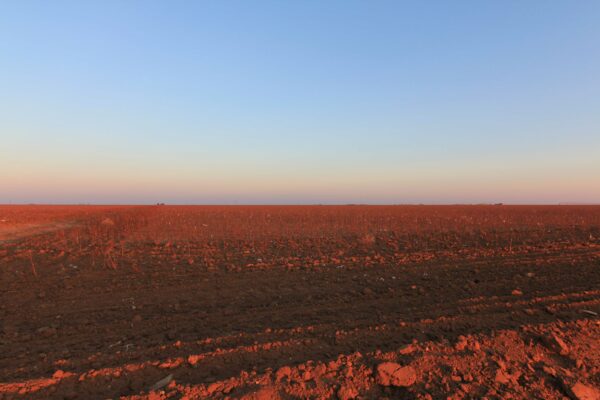
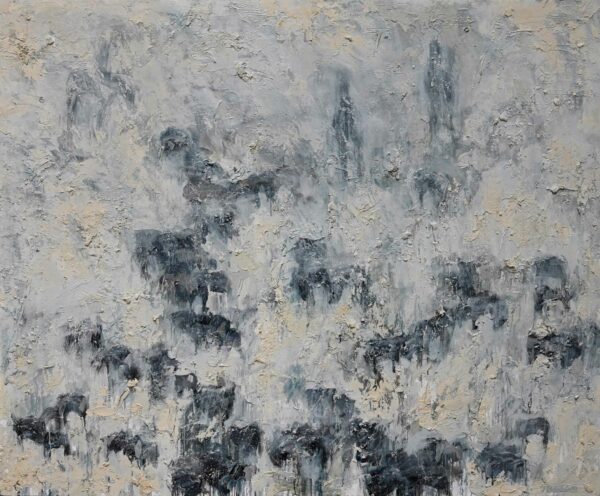

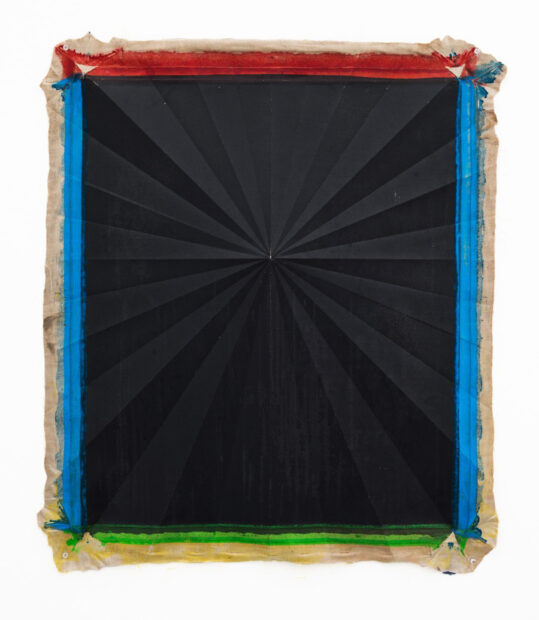
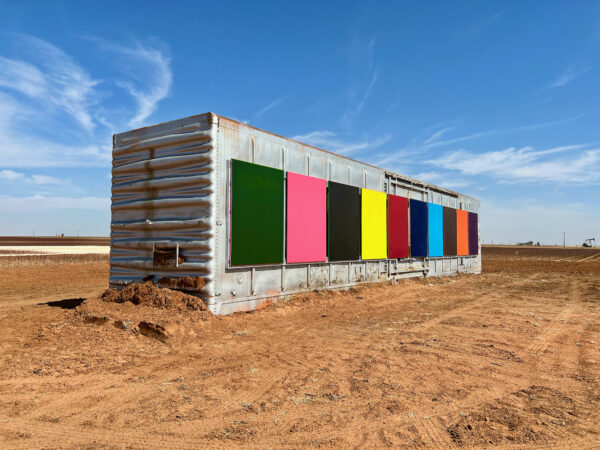

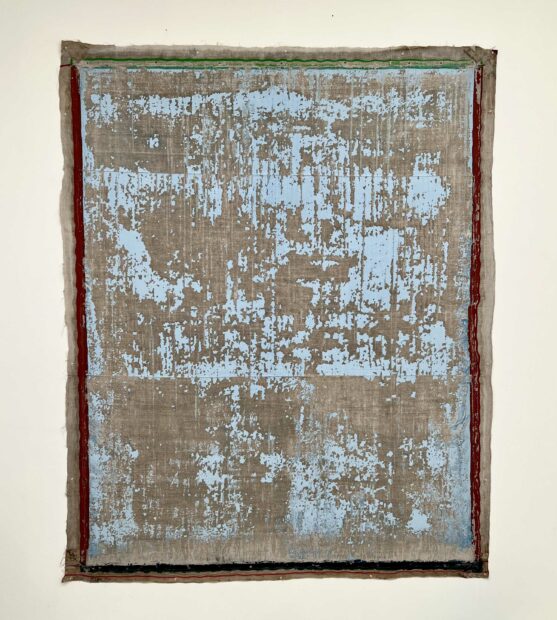
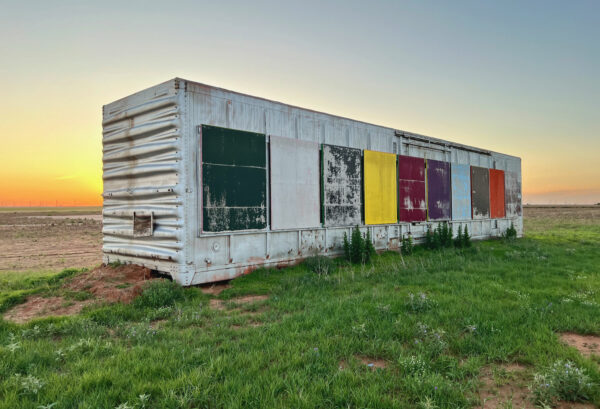

4 comments
Beautiful writing, thank you Hills and artists. Love this: “all those portmanteaus that ring Lubbock like reminders of what is literally right before your eyes: Littlefield, Levelland, Shallowater, Brownfield, Plainview. (Grassland and Southland, for completists.)” And I wonder: did Waddell become a vegetarian when he quit ranching?
Great writing Hills. Thank you for the history and richness for a pretty desolate area that makes some compelling art.
I could read you’re writing all day. I didn’t want it to end. Hopefully you’ll share more often.
Rainey, Ryder Richards, and Bob Russell — thank you for your kind and generous comments. I”m happy you enjoy!